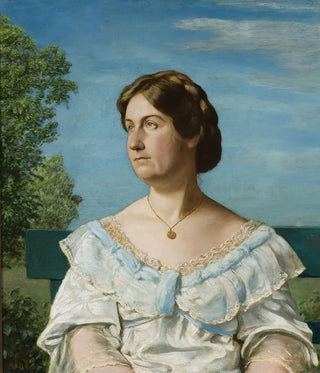Art print | Portrait of the artist Ella Blaue's adopted daughter - Hans Thoma


View from behind

Frame (optional)
Portrait of the artist's adopted daughter Ella Blaue - Hans Thoma – Captivating introduction
In the vast universe of art, some works stand out for their ability to capture the very essence of humanity. The "Portrait of the artist's adopted daughter Ella Blaue" by Hans Thoma serves as an emblematic example of this quest for emotional truth. Through this painting, the artist manages to transcend the simple portrait to offer a window into the soul of his subject. The piece invites the viewer to immerse themselves in a world where tenderness and affection blend with deep introspection, making each gaze upon the canvas unique and personal.
Style and uniqueness of the work
Hans Thoma's style is often characterized by a delicate and poetic approach to human representation. In this portrait, the chosen color palette evokes a soft and warm atmosphere, where skin tones blend harmoniously with the backgrounds. The artist uses subtle brushstrokes to create textures that make the flesh appear lively and vibrant. Ella's eyes, bright and expressive, seem to tell a story, a depth of soul that irresistibly draws the gaze. Thoma, a master of light, plays with shadows to emphasize the delicate features of his model, giving the whole piece an almost spiritual dimension. This portrait is not merely a representation but a dialogue between the artist and his subject, a silent dance between life and art.
The artist and his influence
Hans Thoma, an emblematic figure of the German artistic movement at the end of the 19th and beginning of the 20th century, knew how to mark his era with a unique vision of art. Influenced by Romanticism and symbolism, he integrated elements of nature and mythology into his works, creating an atmosphere that is both intimate and universal. His approach to portraiture, focused on expressing emotions, paved the way for many artists who followed. Thoma does not merely reproduce reality; he seeks to extract its essence, to reveal the hidden feelings behind each face. His ability to establish an emotional connection with the viewer is one of the reasons why his work continues to inspire

Matte finish

View from behind

Frame (optional)
Portrait of the artist's adopted daughter Ella Blaue - Hans Thoma – Captivating introduction
In the vast universe of art, some works stand out for their ability to capture the very essence of humanity. The "Portrait of the artist's adopted daughter Ella Blaue" by Hans Thoma serves as an emblematic example of this quest for emotional truth. Through this painting, the artist manages to transcend the simple portrait to offer a window into the soul of his subject. The piece invites the viewer to immerse themselves in a world where tenderness and affection blend with deep introspection, making each gaze upon the canvas unique and personal.
Style and uniqueness of the work
Hans Thoma's style is often characterized by a delicate and poetic approach to human representation. In this portrait, the chosen color palette evokes a soft and warm atmosphere, where skin tones blend harmoniously with the backgrounds. The artist uses subtle brushstrokes to create textures that make the flesh appear lively and vibrant. Ella's eyes, bright and expressive, seem to tell a story, a depth of soul that irresistibly draws the gaze. Thoma, a master of light, plays with shadows to emphasize the delicate features of his model, giving the whole piece an almost spiritual dimension. This portrait is not merely a representation but a dialogue between the artist and his subject, a silent dance between life and art.
The artist and his influence
Hans Thoma, an emblematic figure of the German artistic movement at the end of the 19th and beginning of the 20th century, knew how to mark his era with a unique vision of art. Influenced by Romanticism and symbolism, he integrated elements of nature and mythology into his works, creating an atmosphere that is both intimate and universal. His approach to portraiture, focused on expressing emotions, paved the way for many artists who followed. Thoma does not merely reproduce reality; he seeks to extract its essence, to reveal the hidden feelings behind each face. His ability to establish an emotional connection with the viewer is one of the reasons why his work continues to inspire






